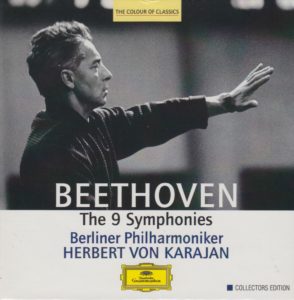 Austrian conductor Herbert von Karajan (1908-1989) scares me.
Austrian conductor Herbert von Karajan (1908-1989) scares me.
The Cult of Karajan is a powerful one, with many music aficionados revering him and the ground he walked on.
I’ve tried to separate that – with varying degrees of success – from my listening experiences with the late Maestro. His bio on Wikipedia doesn’t make it easy, though:
[Karajan] was principal conductor of the Berlin Philharmonic for 35 years. Generally regarded as one of the greatest conductors of the 20th century, he was a dominant figure in European classical music from the mid-1950s until his death. Part of the reason for this was the large number of recordings he made and their prominence during his lifetime. By one estimate he was the top-selling classical music recording artist of all time, having sold an estimated 200 million records.
Well, la-di-da.
I have two box sets from Karajan in this Beethoven project of mine. That’s because when I Googled “Best Conductors of Beethoven Symphonies” or “Best Herbert von Karajan Beethoven Recordings” or search terms similar to those, I discovered Karjan’s name came up a lot. I discovered he recorded no less than four Beethoven cycles, two of which are considered must-buy sets: 1963 and 1977. So I bought both, partly because I wanted to hear what difference the passage of some 15 years would make on a conductor’s performance.
This morning’s Beethoven Symphony No. 1 comes from Karajan’s 1963 recording – although that date is actually a misnomer. According to the liner notes, this performance was recorded in December of 1961. In fact, no recording of Beethoven’s symphonies from Karajan from the early 1960s happened in 1963. The performances occurred from December of 1961 through November of 1962. The entire cycle was released by Polydor in 1963, which is where the reference to the legendary cycle comes from, no doubt.
 The orchestra for this morning’s performance of Beethoven’s First is the Berliner Philharmoniker.
The orchestra for this morning’s performance of Beethoven’s First is the Berliner Philharmoniker.
The record label is Deutsche Grammophon, the familiar yellow logo of which always indicates very, very fine Classical music.
This recording is no exception.
Beethoven wrote his symphonies in four parts (except for the Sixth, which is in five). The time breakdown of this particular one (Symphony No. 1 in C Major), from this particular conductor (Karajan, at age 55) and this particular orchestra (Berliner Philharmoniker), at this particular time in history (December 1961) on this particular record label (Deutsche Grammophon) is as follows:
I. Adagio molto………………………………………………………………………………..9:30
II. Andante cantabile con moto………………………………………………………5:50
III. Menuetto. Allegro molto e vivace……………………………………………….3:56
IV. Adagio – Allegro molto e vivace…………………………………………………5:41
Total running time: 24:57
My Rating:
Recording quality: 5 (the DG label doesn’t release crap, except for some noticeable tape hiss, this is first-rate)
Overall musicianship: 5
CD liner notes: Nice, thick 54-page booklet with lengthy essays by Richard Osborne about each symphony, translated into English, German, and French, and all pertinent technical info.
How does this make me feel: 5
As much as I hate to admit it, this is a “Huzzah!”-worth performance and recording. Sure, I feel like I’m joining the Cult of Karajan when I type those words, and I’m ignoring some serious tape hiss in a few quite spots, but I can’t help myself. This performance is brisk, energetic (almost to a fault), and magical.
At 24:57, this is the second shortest (after Haitink’s) performance of Beethoven’s First that I’ve heard so far. That speed, combined with the palpable energy in this recording make it a go-to if one wishes to hear a splendid performance of Beethoven’s Symphony No. 1 in C Major.
NOTE: I’m not sure what to make of the information that Karajan was a Nazi sympathizer back in the days of Hitler. An article on the web site (Music and the Holocaust) tells us this:
In 1938, the same year that Hitler’s Germany annexed Austria, a 30-year-old conductor from Salzburg led the Berlin State Opera in a production of Richard Wagner’s Tristan and Isolde. The show was spectacular, and the Austrian conductor Herbert von Karajan was hailed as a wonder. Soon after, he signed a lucrative contract with Deutsche Grammophon. Already a member of the Nazi party, von Karajan was on the way to becoming one of the leading musicians of the Third Reich. Like many of his fellow non-Jewish German musicians, however, von Karajan was to emerge from World War II relatively unscathed, going on to become one of the most-recorded musicians in the world. While his egotism and ambition were no secret, his political convictions were vague enough to allow the post-war musical world to look the other way.
Constantly striving to further his career, von Karajan was irked by the looming figure of Wilhelm Furtwängler – a man who, despite his politically ambiguous relationship to the Reich, was the undisputed pre-eminent German conductor. The competition between the young von Karajan and the older Furtwängler did not go unnoticed, but few thought that von Karajan posed a real challenge. An exiled Russian princess wrote that von Karajan ‘is very fashionable and some people tend to consider him better than Furtwängler, which is nonsense. He certainly has genius and much fire, but is not without conceit’.
Although von Karajan never involved himself in any explicit political affairs, he profited from the re-organisation of the musical world under Hitler. Most famously, Richard Strauss’s being fired after his defence of a Jewish librettist gave Peter Raabe a job, which in turn allowed von Karajan to take Raabe’s post at the Aachen opera. Eventually his name was included in Goebbels’ list of musicians ‘blessed by God’. However, even he was not to remain immune from the Führer’s notoriously fickle affections. In 1939 von Karajan led a performance of Wagner’s Die Meistersinger that was a total failure. Hitler, in the audience, took this as a personal affront and purportedly never forgave him. Even more scandalously, von Karajan married Anita Gutermann, the heiress to a textile fortune who was burdened with a Jewish grandfather.
Part of Karajan’s bio on Wikiepdia tells us this:
Karajan joined the Nazi Party in Salzburg on 8 April 1933, but in June of that year the party was outlawed in Austria. In 1939, after the Anschluss, Austrian party memberships were verified by the general office of the Nazi Party, and Karajan’s was declared invalid, possibly because he had also signed up in Aachen, Germany.
Karajan’s prominence increased from 1933 to 1945, which has led to speculation that he joined the Nazi Party solely to advance his music career.
As I wrote at the bottom of my review on Day 5 of Karl Bohm’s interpretation of Beethoven’s Symphony No. 1 in C Major,
Part of me is, like, “So what? Weren’t most Germans Nazis back then?”
And what if Bohm was? A young man in his twenties and thirties, even into his yearly forties, is a different man from when he’s in his sixties, seventies, and eighties. Must a man be forever saddled with what he was, rather than what he is?
I would hate to be known for what I used to be. I like to think I’ve matured and have gotten wiser as I aged. So I’m not going to hold what Karajan and Bohm – and any other from Germany, Austria, or other Nazi-held country in the 1930s and ’40s – used to be against them.
